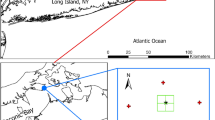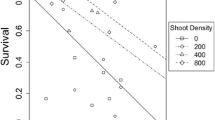Abstract
The scallop Chlamys hastata frequently carries epibionts such as sponges and barnacles on its shells. Although the scallop-sponge relationship has been characterized as a mutualism, little is known about the scallop-barnacle relationship. This study investigated the effects of sponge and barnacle encrustation on the ability of C. hastata to avoid predation by the sea star Pycnopodia helianthoides. In feeding trials, P. helianthoides caught and consumed significantly more barnacle-encrusted scallops (7.7 ± 0.8 out of 20 scallops) than scallops encrusted by either of the sponges Myxilla incrustans (4.1 ± 0.9) or Mycale adhaerens (3.0 ± 0.5). Epibiont-free scallops (5.7 ± 0.5) formed an intermediate treatment between barnacle-encrusted and sponge-encrusted scallops. Possible mechanisms by which the sponges protected the scallops were investigated in two ways: two feeding trials were videotaped to allow qualitative analysis of sea star and scallop behavior and sea star feeding responses to scallop and sponge homogenates were determined to investigate if sea stars accept scallops and sponges as prey. Sea stars displayed positive feeding responses to scallop puree 97.5% ± 1.6 of the time while only displaying positive responses to Mycale adhaerens homogenate 4.4% ± 2.0 of the time and to Myxilla incrustans homogenate 4.4% ± 2.9 of the time. The videotaped feeding trials indicated that interference with tube feet adhesion by the sponge deterred predation. Observations of both sea stars that were videotaped showed that neither avoided trying to capture sponge-encrusted scallops, and at no time was a captured scallop willingly released by the sea stars. Thus, it appears that sponges provide tactile-mechanical protection and possibly chemical or tactile camouflage in this predator/prey relationship. Finally, the effects of sponge encrustation on barnacle settlement were determined. Field experiments showed that barnacle larvae settled more frequently on epibiont-free scallops than on those with either of the two sponges, potentially protecting the scallops from an epibiont that increases the scallop’s susceptibility to predation.




Similar content being viewed by others
References
Amsler, C. D., J. B. McClintock & B. J. Baker, 1999. An Antarctic feeding triangle: defensive interactions between macroalgae, sea urchins, and sea anemones. Marine Ecology Progress Series 183: 105–114.
Armstrong, E., J. D. McKenzie & G. T. Goldsworthy, 1999. Aquaculture of sponges on scallops for natural products research and antifouling. Journal of Biotechnology 70: 163–174.
Bloom, S. A., 1975. The motile escape response of a sessile prey: a sponge-scallop mutualism. Journal of Experimental Marine Biology and Ecology 17: 311–321.
Breen, P. A., 1979. Selective feeding of the sunflower star, Pycnopodia helianthoides, in the laboratory. Fisheries and Marine Service Manuscript Report 1498: 10 pp.
Brewer, R. & B. Konar, 2005. Chemosensory responses and foraging behavior of the seastar Pycnopodia helianthoides. Marine Biology 147: 789–795.
Burns, D. O. & B. L. Bingham, 2002. Epibiotic sponges on the scallops Chlamys hastata and Chlamys rubida: increased survival in a high-sediment environment. Journal of the Marine Biological Association of the United Kingdom 82: 4098–4104.
Cheng J. Y. & M. E. DeMont, 1996. Jet-propelled swimming in scallops: swimming mechanics and ontogenic scaling. Canadian Journal of Zoology 74: 1734–1748.
Chernoff, H., 1987. Factors affecting the mortality of the scallop Chlamys asperrima (Lamark) and its epizoic sponges in south Australian waters. Journal of Experimental Marine Biology and Ecology 109: 155–171.
Conover, W. J., 1999. Practical Nonparametric Statistics, 3rd edn. Wiley and Sons, NY.
Donovan, D. A., J. P. Danko & T. H. Carefoot, 1999. Functional significance of shell sculpture in gastropod molluscs: test of a predator-deterrent hypothesis in Ceratostoma foliatum (Gmelin). Journal of Experimental Marine Biology and Ecology 236: 235–251.
Donovan, D. A., B. L. Bingham, H. M. Farren, R. Gallardo & V. Vigilant, 2002. The effect of sponge encrustation on the swimming behavior, energetics, and morphometry of the scallop Chlamys hastata (Sowerby). Journal of the Marine Biological Association of the United Kingdom 82: 469–476.
Donovan, D. A., B. L. Bingham, M. From, A. F. Fleisch & E. S. Loomis, 2003. Effects of barnacle encrustation on the swimming behaviour, energetics, morphometry and drag of the scallop Chlamys hastata. Journal of the Marine Biological Association of the United Kingdom 83: 813–819.
Feifarek, B. P., 1987. Spines and epibionts as antipredator defense in the thorny oyster Spondylus americanus Herman. Journal of Experimental Marine Biology and Ecology 105: 39–56.
Forester, A. J., 1979. The association between the sponge Halichondria panacea (Pallas) and scallop Chlamys varia (L.): a commensal-protective mutualism. Journal of Experimental Marine Biology and Ecology 36: 1–10.
Hills, J. M. & J. C. Thomason, 1998. The effect of scales of surface roughness on the settlement of barnacle (Semibalanus balanoides) cyprids. Biofouling 12: 57–69.
Kidawa, A., 2005. Behavioural and metabolic responses of the Antarctic sea star Odontaster validus to food stimuli of different concentration. Polar Biology 28: 449–455.
Laudien, J. & M. Wahl, 1999. Indirect effects of epibiosis on host mortality: Seastar predation on differently fouled mussels. Marine Ecology 20: 35–47.
Laudien, J. & M. Wahl, 2004. Associational resistance of fouled blue mussels (Mytilus edulis) against starfish (Asterias rubens) predation: relative importance of structural and chemical properties of the epibionts. Helgoland Marine Research 58: 162–167.
Lescinsky, H. L., 1993. Taphonomy and paleoecology of epibionts on the scallops Chlamys hastata (Sowerby 1843) and Chlamys rubida (Hinds 1845). Palaios 8: 267–277.
Lewis, C. A., 1978. A review of substratum selection in free-living and symbiotic Cirripeds. In Chia, F.-S. & M. E. Rice (eds.) Settlement and Metamorphosis of Marine Invertebrate Larvae. Elsevier, New York: 207–218.
Manly, B. F. J., 1993. Comments on design and analysis of multiple-choice feeding preference experiments. Oecologia 93: 149–152.
Mauzey, K. P., C. Birkeland & P. K. Dayton, 1968. Feeding behavior of asteroids and escape responses of their prey in the Puget Sound region. Ecology 49: 603–619.
McClintock, J. B., B. J. Baker, M. Slattery, M. Hamann, R. Koptizke & J. Heine, 1994. Chemotactic tube-foot responses of a spongivorous sea star Perknaster fuscus to organic extracts from Antarctic sponges. Journal of Chemical Ecology 20: 859–870.
McClintock, J. B., B. J. Baker, C. D. Amsler & T. L. Barlow, 2000. Chemotactic tube-foot responses of the spongivorous sea star Perknaster fuscus to organic extracts of sponges from McMurdo Sound, Antarctica. Antarctic Science 12: 41–46.
McClintock, J. B., C. D. Amsler, B. J. Baker & R. W. van Soest, 2005. Ecology of Antarctic sponges: an overview. Integrative and Comparative Biology 45: 359–368.
Peterson, C. H. & P. E. Renaud, 1989. Analysis of feeding preference experiments. Oecologia 80: 82–86.
Pitcher, C. R. & A. J. Butler, 1987. Predation by asteroids, escape response, and morphometrics of scallops with epizoic sponges. Journal of Experimental Marine Biology and Ecology 112: 233–249.
Pond, D., 1992. Protective-commensal mutualism between the queen scallop Chlamys opercularis (Linnaeus) and the encrusting sponge Suberites. Journal of Molluscan Studies 58: 127–134.
Quade, D., 1979. Using weighted rankings in the analysis of complete blocks with additive block effects. Journal of the American Statistics Association 74: 680–683.
Roa, R., 1992. Design and analysis of multiple-choice feeding preference experiments. Oecologia 89: 509–515.
Sears, M. A., D. J. Gerhart & D. Rittschof, 1990. Antifouling agents from marine sponge Lissodendoryx isodictyalis Carter. Journal of Chemical Ecology 16: 791–799.
Thieltges, D. W., 2005. Benefit from an invader: American slipper limpet Crepidula fornicata reduces star fish predation on basibiont European mussels. Hydrobiologia 541: 241–244.
Tsukamoto, S., H. Kato, H. Hirota & N. Fusetani, 1997. Antifouling terpenes and steroids against barnacle larvae from marine sponges. Biofouling 11: 283–291.
Valentincic, T., 1983. Innate and learned responses to external stimuli in Asteroids. In Jangoux, M. & J. M. Lawrence (eds.), Echinoderm Studies, vol. 1. Balkema, Rotterdam: 111–138.
Waddell, B. & J. R. Pawlik, 2000. Defenses of Caribbean sponges against invertebrate predators. II. Assays with sea stars. Marine Ecology Progress Series 195: 133–144.
Wahl, M. & M. E. Hay, 1995. Associational resistance and shared doom: effects of epibiosis on herbivory. Oecologia 102: 329–340.
Wahl, M., M. E. Hay & P. Enderline, 1997. Effects of epibiosis on consumer-prey interactions. Hydrobiologia 355: 49–59.
Willemsen, P. R., 1994. The screening of sponge extracts for antifouling activity using a bioassay with laboratory-reared cyprids larvae of the barnacle Balanus amphitrite. International Biodeterioration and Biodegradation 34: 361–373.
Acknowledgements
We wish to thank the faculty and staff at Shannon Point Marine Center for research space and support, and the Anacortes Marina for providing dock space for the field experiment. Brian Bingham, Gene McKeen, Giséle Muller-Parker, and Nathan Schwarck helped immensely with scallop collection. Sandra Caldwell and Patrick Gloman assisted with data collection. The barnacles that settled on the caged scallops were identified by Dr. William Newman at Scripps Oceanographic Institute. Dr. Tom Carefoot, Dr. James McClintock, and an anonymous reviewer provided helpful feedback on various drafts of the manuscript.
Author information
Authors and Affiliations
Corresponding author
Additional information
Handling editor: K. Martens
Rights and permissions
About this article
Cite this article
Farren, H.M., Donovan, D.A. Effects of sponge and barnacle encrustation on survival of the scallop Chlamys hastata . Hydrobiologia 592, 225–234 (2007). https://doi.org/10.1007/s10750-007-0743-1
Received:
Revised:
Accepted:
Published:
Issue Date:
DOI: https://doi.org/10.1007/s10750-007-0743-1




